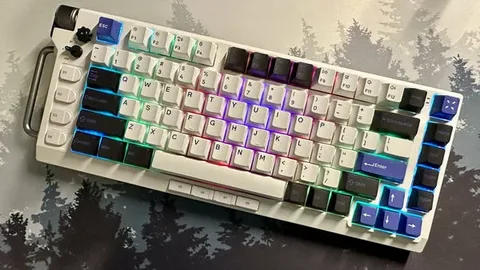When it comes to choosing a mechanical keyboard, enthusiasts often find themselves torn between functionality and aesthetics. One layout that has surged in popularity due to its unique balance is the 75% keyboard layout. In this article, we’ll dive into the 75 keyboard layout explained: the perfect balance of form and function, exploring what it offers, why it’s a favorite among many users, and whether it might be the right fit for you.
What is a 75% Keyboard Layout?
A 75% keyboard layout is a compact version of a standard tenkeyless (TKL) keyboard. It retains all the essential keys, including the function row, arrow keys, and navigational cluster (like Page Up, Home, and End), but arranges them more tightly to save space. Typically, a 75% keyboard has around 84 to 87 keys, depending on the manufacturer.
This layout eliminates the numeric keypad, which helps reduce the keyboard’s width while keeping important keys within easy reach. The result is a clean, space-efficient design that maintains full functionality for most users.
Design and Ergonomics
The compact nature of a 75% layout doesn’t just save desk space—it also contributes to improved ergonomics. With your mouse closer to your keyboard, you reduce unnecessary arm movement, which can enhance comfort during long working or gaming sessions.
From a design perspective, the 75 keyboard layout explained: the perfect balance of form and function also extends to visual appeal. Its tighter layout creates a more symmetrical, sleek look that blends well in modern setups, whether minimalist or tech-heavy.
Why Choose a 75% Keyboard?
Here are some of the main reasons users choose a 75% keyboard:
- Space Efficiency: Ideal for small desks or mobile setups.
- Full Function Row: Unlike 60% or 65% layouts, it retains the top row of function keys, useful for shortcuts and productivity.
- Clean Aesthetic: Compact yet complete, offering a professional and tidy appearance.
- Portability: Lighter and smaller than a full-size or TKL keyboard, making it easy to carry.
For those who want a streamlined keyboard without sacrificing essential keys, the 75 keyboard layout explained: the perfect balance of form and function perfectly sums up why it’s becoming a go-to choice.
Is It Right for You?
If you rarely use the number pad but still need the function row, arrow keys, and navigation keys close at hand, a 75% layout might be ideal. It strikes a rare balance—more compact than a TKL but more practical than a 60% layout.
Whether you’re a developer, writer, gamer, or designer, the 75 keyboard layout explained: the perfect balance of form and function showcases a smart compromise between utility and space-saving elegance.
Conclusion
In the world of keyboards, form and function often compete. But with the 75% keyboard layout, you don’t have to choose one over the other. As we’ve seen in this 75 keyboard layout explained: the perfect balance of form and function breakdown, this layout offers both a compact footprint and comprehensive utility, making it one of the most balanced and beloved keyboard formats today.


